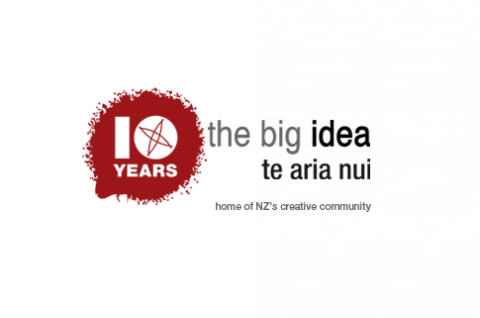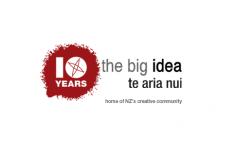Looking back
2001-11 in New Zealand visual arts
As part of The Big Idea’s celebration of ten years online, critic Mark Amery brought together a discussion of those years in the visual arts from five leading visual arts practitioners, including writer and curator Rob Garrett.
Garrett began the decade in Dunedin and now plays a major role in the visual arts from Auckland.
Some of the things that have characterised the visual arts in the last ten years in relation to my particular interests and experience.
One of the most noticeable things has been the nature of advocacy conversations. There has been a sea-change; and the nature of the conversation has shifted. Up to about ten years ago a lot of the advocacy work was aimed at getting the visual arts onto the agenda of mainstream organisations and into the minds of business leaders, on the understanding that there were widespread unrealised benefits to be achieved.
Nowadays there is more widespread understanding of the benefits to be gained from engaging with the arts: both that support for the arts contributes to a well-rounded society; and that instrumental outcomes can be leveraged for organisations and their clients, customers and communities through the arts. In my experience today’s conversations revolve more around how to get the best art results and the greatest instrumental benefits by engaging the right expertise from the outset. This is not to suggest that sponsorship has been any easier, especially in the past three years, for it hasn’t; but there has been a real shift in attitude and understanding.
Works of art and experiences that speak strongly to the tenor of the last ten years, and why.
One of the most memorable art works and experiences I have had in the past five years was a highly conceptual piece about ‘empire’ (authoritarian political and social systems) that was preposterously funny and instantly ‘gettable’. It was this combination of head (concept), heart (emotion) and hand (immediacy) that made it successful, and that make it a useful metaphor for what audiences are looking for.
I believe an interest in audiences, who they are, what they want and how they experience things is a co-requisite to the role of the curator; for it is a curator’s business to find the best ways to bring interesting art to audiences in ways that will both honour the art and reward audiences.
Paul Pfeiffer's video art work Empire (2004) which I saw at Hamburger Bahnhof in Berlin is literally three months long... That's right, the piece is a single three-month-long take. Yet watching five minutes of a three month video did really count for something as a complete art experience.
It appealed to my sense of humour: the improbability of it. It also appealed because it was quite humble and straightforward. The impossibility of viewing the work as a whole did not come across as some sort of arrogant snub. Because the artist has simply set up a surveillance quality video camera where he can capture a queen wasp building her nest and growing her colony of wasps over three summer months, from start to finish, any one three minute segment you watch is going to be pretty similar to any other three minute segment. Similar, except for the sorts of differences that are quite predicable: the nest will be bigger and there'll be more wasps! That's all it is... a simple idea; one camera angle; a single take; but potentially teeming with poetic, philosophical, scary, everyday feelings and ideas, that can literally buzz around inside your head long after having glimpsed a fraction of the whole art work. One idea, picture, action; one long lingering memory.
Some changes in the visual art sector in the last 10 years that have made it easier or harder for New Zealand artists to build a career.
To the extent that “building a career” is about selling art work, special attention must be paid to the last three years, and the impact of the global financial crisis. The art market has suffered a massive shrinkage as people curb spending, drive down debt and begin to accumulate savings. Almost overnight, in the face of the collapse of the country’s property boom and the very tangible lessons of economies worse off than New Zealand’s, values and behaviours changed. Middle and upper income households which formed a major portion of the domestic art market re-prioritised spending.
The changing landscape of art participation has also, I believe, altered much of the domestic art market’s expectations and behaviours. Computer, online and phone technologies have enabled us all to be creatives. Many of us are making images, editing and compiling, and distributing creative content in more diverse and accelerated ways. The apotheosis of spontaneous creation and distribution potential is epitomised in our ability to make a photograph; contextualise it with title, location and comments; and distribute it online through a social networking site within seconds from start to finish.
Equally we can choose to have other’s photographs, videos and discoveries delivered to us for our comment, sharing, or passive rejection. We have come to assume that choices and information are as close as a finger’s tap or swipe on our smart devises. It is worth pondering how all of this compares with the distribution model represented by the conventional gallery, and the efforts required for the same audience to experience works in an exhibition.
Some of the opportunities and challenges of the next decade.
I believe that the conventional distribution models need to change if they are to be effective for artists and relevant to audiences. Among the challenges is the decline in patronage and sales across much of the private gallery and artist studio sector.
However, I don’t see any shrinkage in the interest in the visual arts. There are opportunities too. I see potential for innovative changes to the current gallery business models in the face of market shifts. There is also an opportunity to engage audiences that currently do not ever go to galleries. The rise in popularity of art collector groups, pop-up projects and spaces, public art activity, the Auckland Art Fair, Auckland’s Art Week, and the longest-running outdoor sculpture exhibition, NZ Sculpture OnShore provide clues to where the opportunities lie.
Sculpture OnShore in 2010, for instance, had an audience of 18,000 over the course of two weeks, and 40 percent of these attested that they never go to galleries. Couple this with the fact that 42 percent of Auckland’s population is comprised of new migrant communities which I think are significantly under-engaged in the visual arts sector, and I am increasingly concerned that the visual arts have slipped from any vanguard role they may have once had. What if these figures are roughly representative of the size of audience that is inadequately provided for?
This latent and under-developed audience is not homogeneous; but I suspect there are a number of keys to future success, including people’s desire for group activity and social experience interwoven with the cultural; personalised “navigation” tools for accessing rich information about the arts; diverse offerings, meaning providing ready access on a “something for everyone” basis; and the opportunity for new experiences and fun.
First published by The Big Idea, 14 December 2011.

